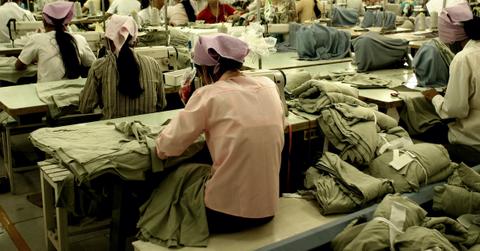100+ Fashion Brands Have Signed the UN Fashion Industry Charter for Climate Action
What exactly is the UN Fashion Industry Charter for Climate Action?
Published Nov. 25 2020, 11:19 a.m. ET

There are so many ways to mitigate climate change and reduce the threats caused by this crisis — and, surprisingly, a lot of these changes lie in the fashion industry, which is responsible for far more pollution and emissions than many people realize.
For that reason, the UN established a Fashion Industry Charter for Climate Action, which aims to reduce the fashion industry’s contribution to the climate crisis. What exactly is the UN Fashion Industry Charter for Climate Action?
Read on for everything you need to know about this important global effort to make the fashion industry more sustainable.
What is the United Nations Fashion Industry Charter for Climate Action?

In 2018, as part of UN Climate Change (the UN branch that works on the global response to the climate crisis), a group of fashion stakeholders got together to address the ways the fashion industry can commit to climate action.
In December 2018, at COP24 in Katowice, Poland, these stakeholders formally launched the Fashion Industry Charter for Climate Action, according to the United Nations Climate Change website. The charter is essentially a series of goals and commitments for the fashion industry as a whole. If the industry can achieve these goals, it will help reduce the clothing and textile sector’s emissions, pollution, overall environmental impact, and ultimately, the industry’s contribution to the climate crisis.
What is the mission of the UN Fashion Industry Charter?
The UN Fashion Industry Charter for Climate Action’s central mission is to achieve net-zero greenhouse gas emissions in the global fashion industry by 2050, in line with the Paris Agreement’s goal of keeping global warming below 1.5 degrees Celsius (2.7 degrees Fahrenheit) above pre-industrial levels.
It’s important to note that net-zero emissions does not mean zero emissions — it means balancing out the emissions being put into the atmosphere with the emissions we are taking out. Many companies and industries do this by focusing on sequestration methods, such as tree-planting. However, the ideal way to do this is by reducing emissions at the source as much as possible — for instance, by keeping oil in the ground.
The charter also has a goal of reducing the fashion industry’s GHG emissions by 30 percent by 2030. Additionally, the charter aims to set a decarbonization pathway for the fashion industry, using tangible methods set by the Science-Based Targets Initiative, an initiative that helps private companies set science-based emissions reduction targets.
Who are the UN Fashion Industry Charter’s members?
Around a hundred brands have signed the UN Fashion Industry Charter, including fashion stores, designers, textile manufacturers, corporations, and more.
Some popular signatories of the charter include: ALDO, Adidas, American Eagle Outfitters, Burberry, Chanel, Esprit, Farfetch, Fossil Group, Gap Inc., G-Star RAW, Guess?, H&M, Hugo Boss, Kering Group, Kmart Group, Levi Strauss & Co, lululemon athletica, Mango, New Balance, Primark, Puma, Ralph Lauren, Target, Stella McCartney, and The RealReal.
There are also several dozen organizations, publications, and councils who are involved in the fashion industry that have signed the charter, including: the Australian Fashion Council, the Better Cotton Initiative, the British Fashion Council, the China National Textile and Apparel Council (CNTAC), the China Textile Information Centre (CTIC), Condé Nast, Fashion for Good, Global Organic Textile Standard (GOTS), OEKO-TEX Association, and the World Wildlife Fund (WWF).
How does the fashion industry hurt the environment?
The fashion industry produces shockingly high greenhouse gas emissions. As per the World Bank, The fashion industry is responsible for 10 percent of global carbon emissions, which is more than the emissions of all global international flights and maritime shipping. If we continue producing apparel at the current rate, the fashion industry’s GHG emissions could increase by more than 50 percent by 2030, according to the World Bank.
These emissions come from a variety of the fashion sector’s components, including drilling for oil to make synthetic fabrics, growing crops such as cotton for fabric, raising animals for fabrics such as leather, wool, and fur, wastewater from fabric dyeing (responsible for 20 percent of the world’s wastewater), water (93 billion cubic meters of water are used by the fashion industry each year), and wasted fabric and surplus clothing that winds up either in the landfill or being incinerated.
Not to mention, there are endless human rights concerns in the fashion industry. About 97 percent of clothing is made overseas, according to The True Cost, and in many of those instances, workers are paid unfair wages and not given proper rights or protections.
Check out some of the links below for guides to shopping for clothing sustainably and ethically.